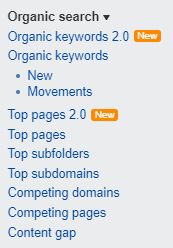Unless you’re one of those people who’s brain goes at 100 miles a minute, then you’ve probably struggled to come up with content ideas for your blog at some point.
Don’t worry, it’s not uncommon to feel like that. Especially if you’re one of a small number of people who are tasked with coming up with ideas.
Add in the fact that it also has to work for your business goals as well and the pressure can soon sap any creativity from you.
So with that in mind, it’s worth having a few tactics in place for generating content ideas for your blog.
The type of tactics that you can throw into the mix when your creativity isn’t quite firing on cylinders.
8 techniques for coming up with content ideas
1. Mining forums for longtail keyword
When you’re creating a blog post you’re looking for that sweet spot between something people are interested in, will generate traffic and that you can write about.
That can be really tough to find.
Conventional wisdom will tell you to do a bit of keyword research, and that will work.
But it can also take ages to do.
So to save time, why not find your keywords from sites that are ranking and already have a starting point to research it from.
A forum.
Forums are great for finding content ideas for your blog because:
- We know there are people interested in that topic
- We know there is search volume around it
- And as a bonus, we potentially have a place to promote it.
The other added benefit of mining blogs for content ideas is that it is really easy to do.
You could do something as simple as using the site search on the forum with a topic that is related to your business.
However, I like to take it a step forward and do the below.
Step 1: Open your favourite SEO tool
I use Ahrefs but you could use SEMRush or any other software that gives you an overview of what a site is ranking for.
Step 2:Plug in the forum of your choosing

Step 3: Take a look at the terms they’re ranking for

Step 4: Filter the keywords to only contain the topic you want to cover

Step 5: Filter the terms for 3 or 4 words or more

And voila! You should have a list of longtail keywords from the forum. It’s just about going through them and cherry-picking the ones that you want to create on your blog.
2. Mining Youtube for longtail keywords
Just like Forums, Youtube is also a great source for finding topics to cover on your blog
Youtube has millions of videos that are added to it daily on every subject. Which sort of makes it a melting pot of ideas perfect for taking inspiration from.
Mining keywords from Youtube is the exact same process as it is from a forum but with one important added step…
You need to double-check the SERPs for each.
Yep, the searches that Youtube ranks for will all have video intent. This means that most of the results will be video and that there will be limited opportunity for long-form written content to rank.
Which makes the terms a bit more competitive.
So before I choose one of the keywords to create content around, I’ll just sense check it by:
Step 1: Putting the search term into Google
The first step is to put the search term into Google and check the number of Youtube results Vs the number of blog posts there are.
What I’m trying to do here is get an idea of the room there is to appear on page one.
If there is a good balance between long-form written content and Youtube results, then there is a lot more positions that you can target.
If it’s low, then I might want to steer clear of it because the diversity of the SERPs is limited.
Step 2: Check the strength of the current ranking pages
Before I spend an afternoon hunched over my laptop, developing a mild case of carpal tunnel, I try to get an idea of the chances of getting traffic.
To do that you have I figure out how strong the current ranking pages are by looking at:
- What is the topical relevance of the post?
- Is it specifically about that subject?
- How well does it answer the search?
- How authoritative is this piece of content?
- Is the number of sites it is linked to from a lot?
- Has it been shared a lot by other sites?
- How authoritative are the sites that are ranking?
- Are the sites well-established brands in that vertical?
- Do they have a lot of domain authority?
If the answer to a few of those questions is no or we can do better than them, then I’ve found the perfect content idea for the blog.
3. Picking Off Your Competitors Low Hanging Fruit
If you want to be tactical about how you come up with content ideas for your blog, then why not use your competitors as inspiration.
Now I’m not saying copy their content. I’m saying find the topics that work for them and do it better or do it with a twist.
The best way to do this is to take their blog and look for opportunities that they currently aren’t capitalising on. Or in other word, terms that don’t rank on page 1.
To do that, I’ll do the following:
Step 1: Put the blog into Ahrefs
Take the blog and plug it into Ahrefs site explorer like below.
![]()
Step 2: Find all the keywords that it ranks for
Got to Organic Keywords.

Step 3: Filter for terms that only rank in position 11 or higher
Once you’ve got the full list of keywords you’ll want to start looking at the low hanging fruit. And by low hanging fruit, I mean terms that they don’t rank as well for.
So to do this, I filter every term for position 11 or lower.
These are the terms that should be more achievable to target.

Step 4: Export and start grouping in a pivot table
Once I’ve got all those keywords, what I like to do is start to group them by URL.
What this does, is it gives me an idea of the type of post that is ranking for these terms. It also allows me to prioritise ideas based on the volume of terms it ranks for.
So for example, if I see a post that ranks for 5 or 6 different terms, then it’s worth considering above a post that ranks for less.
4. Find trending topics on Google trends
We all know Google trends is great for finding the interest in a topic over time. But it is also pretty handy for coming up with content ideas for your blog.
There are two features in particular that are really useful:
The related topics feature

This feature has a couple of powerful filters.
The most important one is the rising filter which allows you to see the trending topics.
If you regularly check in on your core topics and look at the rising related topics, you can quickly jump on a trend to create posts around it.
The related queries feature

Just like the related topics feature, you can use this to find the trending search queries that are related to your core topics. Then with a little bit of ideation you’ve got a relevant and timely piece of content.
5. Mining Pinterest for listicle opportunities
Pinterest ranks really well for “ideas”, “inspiration” and “design” type terms. Which means it is an absolute goldmine for listicle ideas.
So there are two ways in which I mine it for content ideas.
The first is the exact same process we used for mining forums. I’ll plug it into my favourite SEO tool of choice, find the top pages or keywords and then use a bit of excel wizardry and critical thinking to identify some opportunities.
The other method that I will do, is to use the search bar at the top.
I’ll make a list of terms that are related to the topic I want to write about and start plugging them into it.
I’ll then pull any interesting autosuggestions that appear.
From there I’ll go and do an additional bit of keyword research to validate them and then voila! I’ve got some useful content ideas.
6. Using Google images to find related topics and entities
Google image search is one of the most underrated tools for finding related topics to your blog.
Whenever I’m starting on a content strategy I’ll go to Google Image Search to map different topics related to my core topics.
By using the little pill links at the top of the page you get a great jumping-off point for related topics and entities in which you can cover in your vertical.

So for example, if I’m looking for topics related to women’s jewellery, it would give me:
- Necklace
- Fashion
- Sets
- Diamonds
- Traditional
All I would need to do next is to start applying different formats to the above to spin out different content ideas.
7. Using Google’s Autocomplete
Just like you did with Pinterest and Youtube, Google’s Autocomplete can be a great resource for ideas as well as identifying trending topics.

By typing in a few choice words into the search bar, you can start to see terms and topics that are related to the keywords that you have typed in.
8. Using Google’s Autocomplete On Steroids
So if, randomly typing in a few choice words into Google Autocomplete sounds quite labour intensive (it is), then there are tools that you can use that do it at scale.
My favourite is Answer the Public which basically pulls the auto suggestions for you.

It pulls your term with questions, prepositions, comparison and with the autosuggestion for every letter of the alphabet.

Even just taking a look at the results on the page you should be able to spin up a load of content ideas for your blog.
So there it is. A list of tactics that should make coming up with blog ideas more scalable. The next time that you’re stuck for coming up with ideas for your blog, just head back here and use one of the above and you should be able to overcome that creative block that you’ve been having.
Posts You Might Also Like:
- 7 Steps For Creating Your First Marketing Plan
- How To Create Evergreen Content
- A Website Guide And Checklist
- 6 Reasons Your Google Shopping Ads Aren’t Showing

